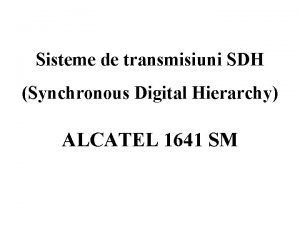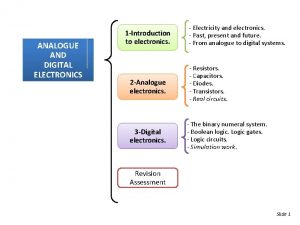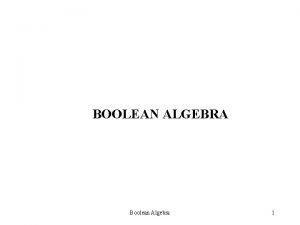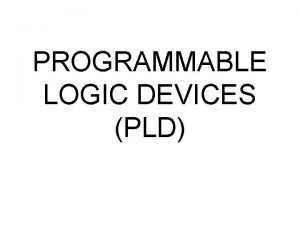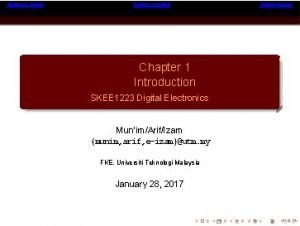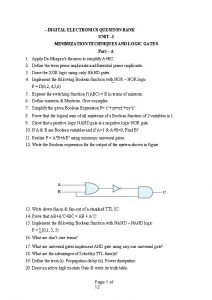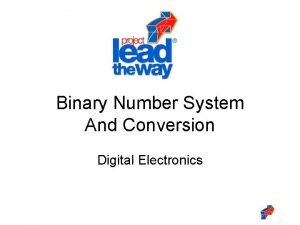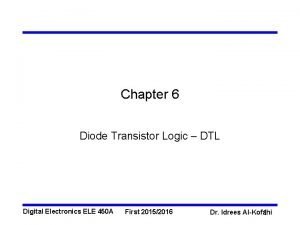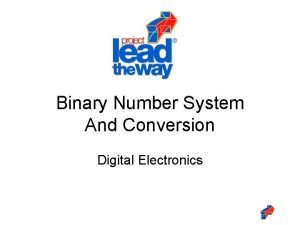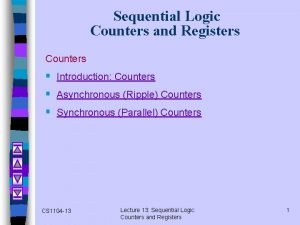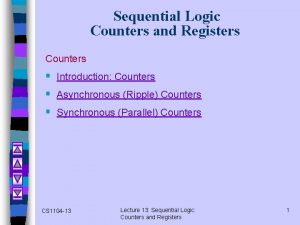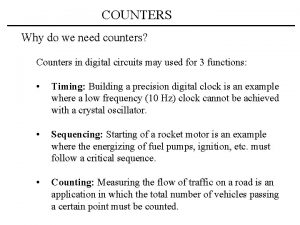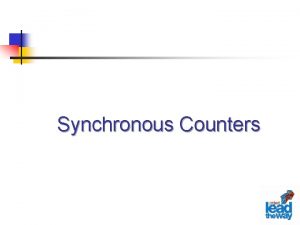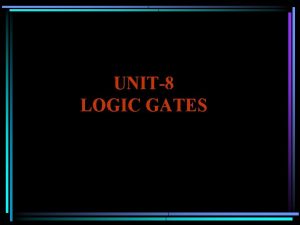Synchronous Counters With MSI Gates Digital Electronics 2014























- Slides: 23

Synchronous Counters With MSI Gates Digital Electronics © 2014 Project Lead The Way, Inc.

Synchronous MSI Counter This presentation will • Introduce the 74 LS 163 Synchronous 4 -Bit Binary Up Counter. • Review the 74 LS 163’s connection diagrams, signal descriptions, logic and timing diagrams. • Provide an examples of a counter application implemented with the 74 LS 163. • Introduce the 74 LS 193 Synchronous 4 -Bit Binary Up/Down Counter. • Review the 74 LS 193’s connection diagrams, signal descriptions, logic and timing diagrams. • Provide an examples of a counter application implemented with the 74 LS 193. 2

74 LS 163 Synchronous Binary Up Counter • Four Bit Synchronous Up Counting. • Pre-loadable Count Start • Synchronous Load • Synchronous Clear • Two Count Enable Inputs • Carry-Out Signal for Counter Cascading 3

74 LS 163 Component Diagram From CDS 74 LS 163 Connection Diagram From Datasheet 4

74 LS 163 Signal Descriptions (1 of 2) Signal Name: • • A : Data Input (LSB) B : Data Input C : Data Input D : Data Input (MSB) • • QA : Data Output (LSB) QB : Data Output QC : Data Output QD : Data Output (MSB) 5

74 LS 163 Signal Descriptions (2 of 2) Signal Name: • ENP : Count Enable P • ENT : Count Enable T • LOAD : Data Load • CLEAR : Clears The Counter • CLOCK : Clock Input • RCO : Ripple Carry Out 6

74 LS 163 Logic Diagram 7

74 LS 163 Timing Diagram (1 of 3) A. CLEAR set to a logic (0); Outputs are cleared on next rising edge of clock. B. LOAD set to a logic (0); Outputs are loaded with input data on next rising edge of clock. In this example a 12 (1100) is loaded. A B 8

74 LS 163 Timing Diagram (2 of 3) C. Counting is enabled; ENT & ENP are both set to a logic (1). On every rising edge of clock, the output count is incremented by one. In this example 12, 13, 14, 15, 0, 1, 2. Note, when the count is 15, RCO is a logic (1) for the full clock cycle. C 9

74 LS 163 Timing Diagram (3 of 3) D. ENP set to a logic (0); Counting is disabled. D. ENT set to a logic (0); Counting is disabled. D E 10



74 LS 193 Synchronous Binary Up/Down Ctr • Four Bit Synchronous Up / Down Counting. • Separate Clock Inputs for Up & Down Counting • Pre-loadable Count Start • Asynchronous Load • Asynchronous Clear • Carry-Out Signal for Counter Cascading Up Counters • Borrow-Out Signal for Counter Cascading Down Counters 13

74 LS 193 Component Diagram From CDS 74 LS 193 Connection Diagram From Datasheet 14

74 LS 193 Signal Descriptions (1 of 2) Signal Name: • • A : Data Input (LSB) B : Data Input C : Data Input D : Data Input (MSB) • • QA : Data Output (LSB) QB : Data Output QC : Data Output QD : Data Output (MSB) 15

74 LS 193 Signal Descriptions (2 of 2) Signal Name: • UP : Up Counter Clock Input • DOWN : Down Counter Clock Input • ~LOAD : Data Load • CLR : Clears The Counter • ~BO : Borrow Output • ~CO : Carry Output 16

74 LS 193 Logic Diagram 17

74 LS 193 Timing Diagram (1 of 3) A. CLEAR set to a logic (1); Outputs are cleared immediately. CLEAR is an asynchronous input. B. LOAD set to a logic (0); Outputs are loaded with input data immediately. In this case 13 (1101). LOAD is an asynchronous input. A B 18

74 LS 193 Timing Diagram (2 of 3) C. COUNT UP is clocked and COUNT DOWN is a logic (1). On every rising edge of clock, the output count is incremented by one. In this example 13, 14, 15, 0, 1, 2. Note, when the count is 15, CARRY is a logic (0) for ½ the clock cycle. C 19

74 LS 193 Timing Diagram (3 of 3) D D. COUNT DOWN is clocked and COUNT UP is a logic (1). On every rising edge of clock, the output count is decremented by one. In this example 2, 1, 0, 15, 14, 13. Note, when the count is 0, BORROW is a logic (0) for ½ the clock cycle. 20



74 LS 193 Design Example #2 “ 5” BO CO QD QC QB QA LOAD CLK “ 4” “ 3” “D” “C” “B” “A” “ 9” “ 8” “ 7” “ 6” “ 5” “ 4” “ 3” “D” “C” Repeats → 23
 3 bit asynchronous counter
3 bit asynchronous counter Msi gates
Msi gates Msi logic
Msi logic Synchronous design methodology
Synchronous design methodology Synchronous digital hierarchy
Synchronous digital hierarchy Analogue and digital electronics
Analogue and digital electronics Whats an analog
Whats an analog Digital fundamentals floyd 10th edition
Digital fundamentals floyd 10th edition De morgan
De morgan Boolean
Boolean Aoi logic examples
Aoi logic examples Is camera an electronic device
Is camera an electronic device What is pld
What is pld Inverter timing diagram
Inverter timing diagram Vhmax
Vhmax Minimization techniques in digital electronics
Minimization techniques in digital electronics Example of binary to decimal number system
Example of binary to decimal number system What is dtl in digital electronics
What is dtl in digital electronics System digital
System digital Setup time and hold time in digital electronics
Setup time and hold time in digital electronics Multiplexer and demultiplexer
Multiplexer and demultiplexer Digital electronics chapter 1
Digital electronics chapter 1 Complement in digital electronics
Complement in digital electronics Ram digital electronics
Ram digital electronics




